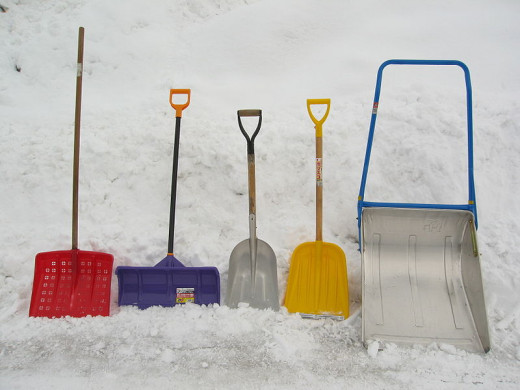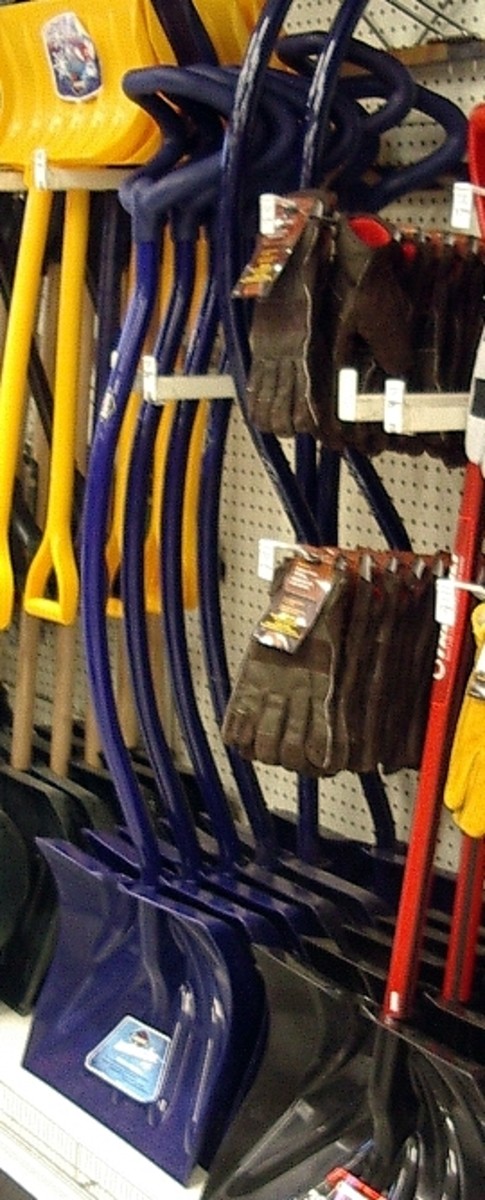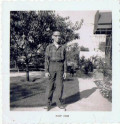How Do I Snow Shovel Safely and Correctly?

It's a pain
I can hear them already.
Somewhere in the heart of central New Jersey and all parts north and colder, people are screaming about pain in their backs. If you listen even closer, you can hear the sound of local chiropractors giggling. It’s that time of year again – although in New Jersey “that time of year” is happening earlier and earlier. Snow is falling into places where it needs to be cleared.
And with that most of us need to shovel snow.
I say most of us because there is a class of people out there who will eagerly pay someone else to do it or have a snow blower all primed and ready to go. The ones that pay other people like me (when I was between the ages of 12 to 18), may not be doing this out of laziness but like to see a young man take advantage of an opportunity and live in the spirit that hard work and cleverness will make you money. The ones that own a snow blower are just smart investors who know the price of that machine is equal to ten trips to the chiropractor and want to avoid the financial and physical pain of improper shoveling techniques.
Those of us who are like me are too poor to make the investment and look at their one hundred foot driveway with fear and dread the moment a snowflake lands on their asphalt. They have to make due with a shovel and a whole lot of self-motivation to get out there and work.
It’s a tradition and a comedy all rolled up into one.
Those of us who go through this seasonal dread know that the difference between pure exhaustion in doing this type of work and pure exhaustion with added back pain all boils down to technique, preparation, and pacing. The only thing that will make it go easier is if they have help in their effort.
So, if you want to save yourself agony and expense, follow these steps.
What you need
The first thing you need is the actual will to do the shoveling.
I won’t lie to you; if you have a lot of driveway to clear and a long walk, this task is quite daunting. The tendency to procrastinate in getting this done is similar to getting a tooth extraction from a barber. You really don’t want to do it. Unless you’re like my twenty eight year old next door neighbor that LOVES DOING THIS, you may have some trouble finding the gumption to get yourself out of bed and doing what needs to be done.
I use the argument that the longer I wait, the worse it will get. The only circumstance that this is not true is when there is less than five inches of snow on the ground and the probability that the weather will get dramatically warmer during the day. This rarely happens and if it does you’ll need to be sure that the temperature doesn’t drop again that night to form ice.
The best way to look at doing this job is in a series of steps and phases. Think about doing a certain number of feet and then take a fifteen minute break. If you’re feeling tired after the break, rest. On the other hand, if you’ve completed the first section without exhaustion, just take a shorter break. You want to ride on that little bit of adrenaline and refuel to get it going again.
You will need a warm jacket. I recommend something that allows movement. Use a ski jacket or something lined with “Thinsulate”. These new jackets while heavy and dense allow for movement and warmth. In addition to the jacket, you’ll need a pair of waterproof gloves – not mittens. You’ll need some dexterity with your hands. I recommend gloves with grips in the palm and fingers. They’re better to hold the shovel.
While you’re doing this work, I’d advise you to wear long johns (aka “thermal underwear”) under your pants. Because I believe that jeans are really for working and doing chores, you might want to wear a pair of denim jeans – however, if you have “snow pants” or something worn for ski season and you feel comfortable wearing them, do that. I prefer denim jeans because they work better for hard work.
A pair of work boots or rubber boots with gripped soles will help keep your feet dry in the snow and help you from slipping on “black ice” – although I’ve still not found the shoe or boot that is fool proof against that. I, of course, am the test “fool” for these types of products.
Slipping and falling on asphalt or concrete hurts.
You will also need four tools for the snow removal: a standard broom, a “push” snow shovel, a “flat” snow shovel (if it’s metal, consider spraying nonstick Teflon on it), a wheel barrow, and rock salt (pet friendly, if possible) or snow melting chemicals.
What do you do when it snows?
What to do before shoveling
This is important – it will help you reduce your chances of injury or heart attack: Stretch and Warm up.
No, I’m not kidding.
Think about what you’re doing. You’ll be engaging in repetitive motions, lifting weights, aerobics, and excessive bending. If I told you that you’d be doing this in a gym, you’d be doing stretching exercises and a warm up. This is no different than a recreational work out except you’ll actually be accomplishing something by the time you end it.
So take about five minutes before you start working to do some basic stretching exercises, some deep knee bends, and work with limbering your back and shoulders. All of these body parts will certainly come into play.
You should also take this time to plan out how you’re going to shovel. If this is your first winter, you’ll want to set up benchmarks and know what you’re going to do for each one of your breaks.
And lastly, if you don’t feel your health is up to it, pay someone else to do it. You’ll know this if 1) you are getting short winded and have dizzy spells and 2) if your doctor says you shouldn’t be doing this.
If you are a working professional who has the option to work from home, you’ll need to notify your supervisor that you will not be available while you’re shoveling. If this is a problem, you’ll need to either call someone to do this chore for you or schedule your shoveling for your off hours. Hopefully, you’ll have an understanding boss who will realize your home comes first.
Getting started
The general assessment and strategy you’ll need to take before shoveling will all depend on two major factors: how much area you have shovel and how deep the snow is.
If you have a lot of snow and a lot of area to cover, you may wish to recruit some help. If there is no help to be gotten, you’ll need to pace yourself. This is not a race. Chances are if you have that much snow, you’ll be either working from home or you’ve called in.
If the snow is shallow (6 inches deep or less), use your “push” snow shovel to push the snow into its scooper before you throw it into your wheel barrow. If it’s really shallow (3 inches or less) just push it to the sides. A minimal effort is required.
I made mention of a wheel barrow in the things you’ll need. Remember, the title of this article is how to do this correctly. This would mean that you don’t throw snow on your side plants, bushes, or other things that will not grow back if you dump massive amounts of weight on them. Use the wheel barrow as something to haul the excess snow to a better place. It will also help you in how you lift and dump the snow.
That being said, if you have a massive amount of snow to shovel, the wheel barrow will help you immensely once you’ve cleared a small section of drive way. You’ll need to work in small squares of space. I recommend six foot by six foot patch with the wheel barrow nearby. Fill the wheel barrow, dump it, and begin another patch… repeat.
Do this until you reach your first goal and then rest.
Snow removal stuff on Amazon
The proper mechanics and technique in snow shoveling
If I were to tell you “just shovel” you might get so angry with me that you’d destroy your own laptop.
So, I’m not going to tell you that. Use these rules:
- Just like every other bit of heavy lifting technique, you’ll need to lift with your legs. The temptation to lift with using your lower back is the doom of all snow shovelers. Bend your knees, scoop the snow, and dump the snow into your wheel barrow.
- Limit the amount of snow you lift with your shovel. Lifting herculean snow boulders with your shovel may impress the ladies but your back is going to call you “Joe Stupid” later on. When you have huge drifts of snow, shovel in levels with your “flat” snow shovel. Don’t scoop from the bottom. The main reason why you shouldn’t scoop large amounts of snow from the bottom is that you’ll get the melted watery slush that is heavier than the powder at the top.
Slice the top layer, slice the middle layers until you have two inches of slushy snow at the bottom. Then shovel that heavy, wet, slushy, snow at the bottom – and dump it all in the wheel barrow. Back strain happens when people lift heavy loads and throw it a long distance, wrenching their lower back. - If you have to deal with icy frozen snow at the bottom near the asphalt, consider using rock salt to soften the ice. Wait for the salt to do its job and shovel the melted stuff. If it’s not melted use more rock salt or ice melter. The pet friendly ice melting products not only do a decent job at this, but they also protect your pets’ feet.
- If you feel tired, dizzy, or experience chest pains or nausea, STOP SHOVELING AND REST!
- After you’ve finished shoveling all of the snow, spread rock salt or pet safe snow melting chemicals on the areas you’ve shoveled. These chemicals should keep the water from freezing and stop a thin layer of black ice from forming if the temperature drops in the evening.
Final Words
Snow shoveling is a colossal pain any way you slice it.
However, it is a necessary evil especially if you have to get your car out of the driveway in order to go to work and earn a living. I always tell people to exercise good judgment. If you have a heart condition, you may want to hire someone else to do the chore or invest in a snow blower. You should not be doing strenuous exercise.
If you are healthy enough to dig your driveway out, you need to avoid many of the common injuries that happen with every snowfall. You should dress warmly, work at a steady pace, and don’t over exert yourself. The two most common injuries are from slipping on black ice and back strain.
You also want to keep warm and dry from working in the snow. A good pair of boots along with a quality pair of long johns will most likely do the trick. This is a job of necessity and very few people look forward to this chore.









